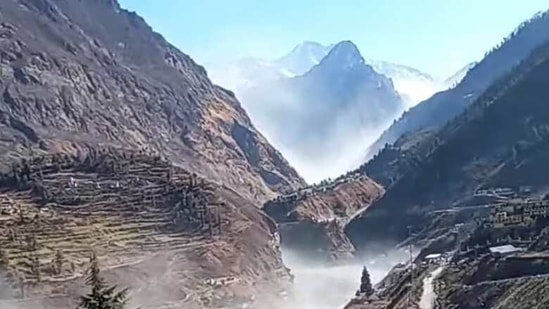Studies hint at faster glacial retreat
The Hindu Kush Himalayan (HKH) region --which covers 3,500 km across Afghanistan, Bangladesh, Bhutan, China, India, Myanmar, Nepal and Pakistan--experienced a temperature rise of about 1.3 degree Celsius between 1951 and 2014.
The Chamoli glacial breach and the disaster it has unleashed may be, in a manner of speaking, just the tip of the iceberg.

Latest scientific research suggests that the retreat of glaciers in the entire Himalayan region, except some parts of the Karakoram range, has gathered pace. This, scientists say, will lead to more frequent disasters induced by glacier melt.
A report modelled on the Intergovernmental Panel on Climate Change’s (IPCC) assessment reports, “Assessment of Climate Change over the Indian Region”, flagged last year that the Himalayas and the Tibetan plateau recorded a warming of 0.2 degrees Celsius per decadeduring 1951–2014. In some of the higher reaches, the warming was at the rate of 0.5 degrees Celsius per decade -- a much higher-than-average warming experienced over the entire country.
The Hindu Kush Himalayan (HKH) region --which covers 3,500 km across Afghanistan, Bangladesh, Bhutan, China, India, Myanmar, Nepal and Pakistan--experienced a temperature rise of about 1.3 degree Celsius between 1951 and 2014 compared to average temperature rise of around 0.7 degrees Celsius during 1901 to 2018 over the country, the report by the Union ministry of earth sciences said. This, the report added, has led to several areas of HKH recording a steep decline in snowfall, and led to a retreat of glaciers in recent decades. The Karakoram Himalayas -- which are the northwestern extension of the Himalayas and cover Gilgit-Baltistan, Ladakh, and parts of China -- however, have experienced higher winter snowfall and therefore far less glacial retreat, the report said.
“There is now consensus that most glaciers in the Himalayas are retreating with the pace accelerating from the beginning of 21st century. As several studies have shown, warming is much higher in the upper reaches of Himalayas, with loss of glaciers, glacial lake formations have increased. These lakes can burst and there can be flash floods. There are a number of mechanisms through which such floods can happen in association with landslides and avalanches. We have also monitored glacial lake formations in the Alaknanda basin and the Nanda Devi glacier. Our team is likely to have some conclusions on the Chamoli disaster soon,” said Professor Anil Kulkarni, distinguished scientist at the Divecha Centre for Climate Change.
Two other reports underlined that more Chamoli-like disasters were likely. One was the IPCC special report on Oceans and Cryosphere in a Changing Climate, in September 2019, and the Hindu Kush Himalaya Assessment by International Centre for Integrated Mountain Development (Icimod), in February 2019.
The IPCC report said glacier retreat and snow cover changes have contributed to localised declines in agricultural yields in some high mountain regions, including the Hindu Kush Himalayas and the tropical Andes. Changes in the frequency and intensity of extreme rain events vary according to season and region. For example, across the Himalayan-Tibetan Plateau mountains, the frequency and intensity of extreme rainfall events is projected to increase throughout the 21st century, particularly during the summer monsoon. It predicted a transition towards more episodic and intense monsoon rain in the Himalayas.
The report also said that, in the Himalayas alone, up to two-thirds of the current and planned hydropower projects are located in the path of potential glacier floods.
The Icimod report, while warning that glaciers have thinned and retreated, said the glacier volume in HKH is likely to decline by 36% in a 1.5-degree global warming scenario, and by 64% by the end of century if current emissions continue. Accelerated warming is likely to cause complete disappearance of debris free lower elevation glaciers and will increase volume losses from glaciers at high elevation gradually.
“Since the 1990s, glacial lakes show a clear increase both in number and in area. Several glacial lakes in the extended HKH are potentially hazardous — and as glaciers continue to retreat, the risk of dangerous glacial lake outburst floods (GLOFs) may increase further,” the report said.
“Rapid retreat of glaciers result in formation of glacial lakes. Therefore, with warming there is increased risks of glacial lake outburst floods (GLOFs) in the future… We find that there are limited number of hydrometeorological monitoring stations in the higher altitude. There is an urgent need to strengthen our network in these locations thereby providing continuous monitoring of our weather and river flow conditions. At the same time there is a need for greater awareness of the communities and infrastructure developers to understand the risks and take appropriate actions,” said Mandira Shrestha, water resources and disaster specialist at Icimod, Kathmandu.
Get Current Updates on India News, Lok Sabha Election 2024 live, Infosys Q4 Results Live, Elections 2024, Election 2024 Date along with Latest News and Top Headlines from India and around the world.



